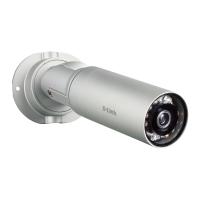
Do you have a question about the D-Link DCS-7010L and is the answer not in the manual?
| Maximum resolution | 1280 x 720 pixels |
|---|---|
| Supported video modes | - |
| Video formats supported | H.264, M-JPEG, MPEG4 |
| Supported graphics resolutions | 1280 x 720 (HD 720), 1280 x 800 (WXGA) |
| Minimum illumination | - lx |
| Sensor type | CMOS |
| Optical sensor size | 1/4 \ |
| Optical zoom | - x |
| Fixed focal length | 4.3 mm |
| Security algorithms | HTTPS |
| IP address filtering | Yes |
| Compatible memory cards | SD, SDHC |
| LED type | IR |
| Night vision distance | 10 m |
| Type | IP security camera |
| Certification | CE, CE LVD |
| Placement supported | Outdoor |
| Connectivity technology | Wired |
| Form factor | Bullet |
| Mounting type | Wall |
| Product color | White |
| International Protection (IP) code | IP66 |
| Audio system | 2-way |
| Ethernet LAN | No |
| Cabling technology | 10/100Base-T(X) |
| AC input voltage | 100-240 V |
| DC output current | 1.2 A |
| DC output voltage | +5V |
| Power source type | PoE |
| AC input frequency | 50 - 60 Hz |
| Power consumption (typical) | 5.4 W |
| Storage temperature (T-T) | -20 - 70 °C |
| Operating temperature (T-T) | -25 - 50 °C |
| Storage relative humidity (H-H) | 5 - 95 % |
| Operating relative humidity (H-H) | 20 - 80 % |
| Compatible operating systems | Microsoft Windows 7/Vista/XP |
| F-number (relative aperture) | 2 |
| Depth | 176.5 mm |
|---|---|
| Width | 65 mm |
| Height | 80.5 mm |
| Weight | 510 g |
| Diameter | 44 mm |
Lists the revision history of the user manual.
Lists registered trademarks of D-Link and other companies.
General introduction to the DCS-7010L HD Mini Bullet Outdoor Network Camera.
Lists all the items included in the camera package.
Detailed description of the DCS-7010L camera and its capabilities.
Specifies the necessary hardware and software to use the camera.
Highlights the key functionalities and advantages of the DCS-7010L camera.
Details the physical components of the camera's front panel.
Describes the camera's cable connections and their functions.
Illustrates and explains the internal parts of the camera, including the SD card slot.
Provides step-by-step instructions for inserting a MicroSD card into the camera.
Guides through automatic camera setup using a mydlink-enabled router.
Instructions for verifying the camera registration and access on the mydlink service.
Step-by-step guide for installing the camera using the provided CD-ROM wizard.
Instructions for installing the camera hardware without the setup wizard.
Details how to mount the camera to a wall using the provided bracket.
Explains how to adjust the camera's angle for optimal viewing after mounting.
Accessing and viewing the camera remotely via the mydlink website.
Explains how to interpret the online status indicators for the camera.
Describes the controls and options available for viewing live video streams.
Instructions for reviewing pre-recorded video clips stored on the microSD card.
Overview of various camera settings accessible through the mydlink interface.
Configuration options for automatic video recording based on events or schedules.
Accessing and configuring the camera's advanced operational parameters.
Managing and viewing event notifications and logs for the camera.
Accessing the camera's web-based configuration utility.
Settings related to viewing and controlling the live video stream from the interface.
Guides through initial network and motion detection setup.
Wizard for configuring network connectivity and internet access for the camera.
Wizard to configure motion detection parameters and alerts.
Detailed configuration of LAN and Internet network settings.
Setting up Dynamic DNS for remote access with a changing IP address.
Adjusting video image parameters like privacy mask, exposure, and white balance.
Configuring video profiles, aspect ratios, codecs, and audio input/output.
Setting up predefined camera positions (presets) for quick access and sequences.
Detailed configuration of motion detection areas, sensitivity, and triggers.
Setting the camera's internal clock and time zone, including daylight saving.
Configuring events, triggers, and associated actions like snapshots or notifications.
Setting up servers (email, FTP) to store recorded media.
Defining media types (snapshot, video clip, system log) and their parameters.
Creating and scheduling specific events with triggers and actions.
Scheduling and configuring continuous or event-triggered video recording.
Browsing, managing, and formatting recorded files stored on the SD card.
Configuring digital input and output ports for external devices and alarms.
Adjusting Day/Night mode and IR light control for low-light conditions.
Enabling secure HTTPS access to the camera by installing certificates.
Setting IP address-based access permissions for viewing the camera.
Configuring Simple Network Management Protocol settings for network management.
Managing user accounts, camera name, and On-Screen Display (OSD) settings.
Backing up, restoring, resetting, and rebooting the camera's system.
Updating the camera's firmware to the latest version for improved functionality.
Displays detailed information about the camera's network connection and firmware.
Viewing and managing the camera's system event logs.
Provides access to helpful information and guidance for camera operation.